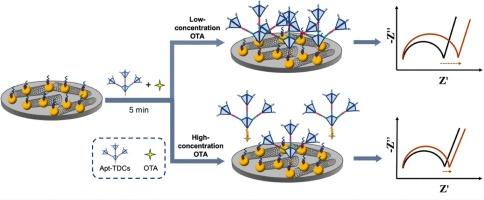基于四面体DNA簇的信号放大阻抗生物传感器超灵敏检测赭曲霉毒素A
IF 4.9
2区 化学
Q1 CHEMISTRY, ANALYTICAL
引用次数: 0
摘要
赭曲霉毒素A (OTA)是一种高毒性真菌毒素,具有肾毒性、肝毒性和致癌性。它对人类和动物的健康构成长期威胁。尽管具有适体功能化的丝网印刷电极(SPE)提供了很有前途的检测能力,但其应用受到固有的微弱电化学信号的限制,这促使了对信号放大策略的需求。本研究制备了四面体DNA簇(TDCs)作为OTA的适配体探针,并建立了基于适配体的OTA电化学传感方法,用于信号放大。设计多个单链DNA (ssDNA)通过碱基互补自组装成四面体DNA纳米结构(TDN), OTA适体附着在一个顶点。进一步利用额外的ssDNA链在剩余的三个顶点上延伸tdn,形成DNA四面体簇。该方法检测OTA的线性范围为1 pg/mL ~ 100 ng/mL (LOD = 1 pg/mL),在饲料样品中具有良好的特异性和令人满意的回收率本文章由计算机程序翻译,如有差异,请以英文原文为准。

Tetrahedral DNA cluster-based signal-amplified Impedimetric biosensor for ultrasensitive detection of Ochratoxin A
Ochratoxin A (OTA) is a highly toxic mycotoxin with nepHrotoxicity, hepatotoxicity, and carcinogenicity. It poses a long-term threat to the health of humans and animals. Although screen printed electrodes (SPE) with aptamer functionalization provide promising detection capabilities, their applications are limited by inherent weak electrochemical signals, prompting the need for signal amplification strategies. In this study, tetrahedral DNA clusters (TDCs) were prepared as aptamer probes for OTA, and an aptamer-based electrochemical sensing method for OTA was established for signal amplification. Multiple single-stranded DNA (ssDNA) were designed to self-assemble into tetrahedral DNA nanostructure (TDN) through base complementarity, with the OTA aptamer attached to one vertex. Additional ssDNA strands were further utilized to extend TDNs at the three remaining vertices, forming a DNA tetrahedral cluster. The method had a linear range of 1 pg/mL to 100 ng/mL (LOD = 1 pg/mL) for detecting OTA, with excellent specificity and satisfactory recovery rate in feed samples
求助全文
通过发布文献求助,成功后即可免费获取论文全文。
去求助
来源期刊

Microchemical Journal
化学-分析化学
CiteScore
8.70
自引率
8.30%
发文量
1131
审稿时长
1.9 months
期刊介绍:
The Microchemical Journal is a peer reviewed journal devoted to all aspects and phases of analytical chemistry and chemical analysis. The Microchemical Journal publishes articles which are at the forefront of modern analytical chemistry and cover innovations in the techniques to the finest possible limits. This includes fundamental aspects, instrumentation, new developments, innovative and novel methods and applications including environmental and clinical field.
Traditional classical analytical methods such as spectrophotometry and titrimetry as well as established instrumentation methods such as flame and graphite furnace atomic absorption spectrometry, gas chromatography, and modified glassy or carbon electrode electrochemical methods will be considered, provided they show significant improvements and novelty compared to the established methods.
 求助内容:
求助内容: 应助结果提醒方式:
应助结果提醒方式:


